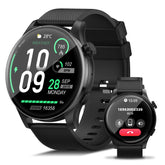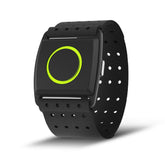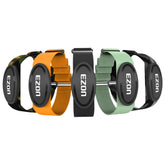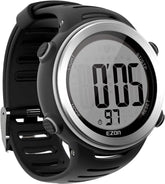Triathlon Training Unleashed: Digital Tools for Swim, Bike, Run Success
Triathlons demand mastery of swim bike run and seamless transitions—no guesswork, only precision. This guide reveals how digital sports watches transform triathlon training, offering real-time insights to optimize each discipline, refine training schedules, and unlock performance optimization. Whether you’re tackling your first sprint or chasing Kona,let technology be your edge.
1. The Triathlete’s Digital Toolkit: Why Every Second Counts
A. Multi-Sport Mode: Seamless Discipline Transitions
- Auto-Detect Activities: Your watch switches from swim to bike to run mode automatically, logging transition times (T1/T2) for post-workout analysis.
- Real-Time Data Overlays: View stroke rate (swim), cadence (bike), and pace (run) on a single screen—no need to toggle settings mid-workout.
B. Training Load Analysis
- Cumulative Stress Score: Algorithms calculate weekly fatigue from swim/bike/run sessions, ensuring you don’t exceed a 10% weekly intensity increase (key for injury prevention).
- Recovery Metrics: Heart rate variability (HRV) and resting heart rate (RHR) guide rest days—low HRV means prioritize yoga over intervals.
2. Discipline-Specific Optimization
A. Swim: Efficiency Over Distance
Key Metrics Tracked
- Stroke Count/50m: Aim for <30 strokes in freestyle to improve efficiency (SWOLF score = time + strokes; lower is better).
- Open Water Sighting: Use your watch’s compass to track buoy angles, reducing off-course distance by 20%.
Workout Example
- Technique Day: 4x100m with 10-second stroke count focus (e.g., “18 strokes per length” alert on your digital sports watch).
- Endurance Day: 30-minute steady swim at 70% max heart rate, practicing rhythmic breathing.
B. Bike: Power, Pedal, and Pace
Power-Based Training
- FTP (Functional Threshold Power): Sync your watch with a power meter to train in zones (e.g., 88–94% FTP for sweet spot intervals).
- Cadence Alerts: Maintain 85–95 RPM on flats, 75–85 RPM on climbs—vibration cues keep you efficient.
Transition Practice
- Brick Workouts: 1-hour bike + 30-minute run; your watch auto-logs both activities and calculates T2 time (aim to shave 1 minute off transitions monthly).
C. Run: Stride Smart, Finish Strong
Form Optimization
- Stride Length/ Cadence: Ideal cadence 170–180 steps/min; use accelerometer data to avoid overstriding (common post-bike mistake).
- Pace Lock: Set goal marathon pace (e.g., 4:30/km) and let the watch vibrate if you’re 5% too fast/slow—critical for negative splits.
Post-Bike Run Drills
- Jelly Legs Acclimation: 10-minute easy run off the bike 2x/week; track heart rate recovery to ensure you’re ready for race-day efforts.
3. Crafting a Data-Driven Training Schedule
A. 16-Week Periodization Plan
Base Phase (Weeks 1–4)
- Goal: Build aerobic base (80% Zone 2 training).
- Digital Tool Use: Schedule equal swim/bike/run time in your watch’s calendar, with auto-reminders for warm-ups/cool-downs.
Intensity Phase (Weeks 5–10)
- Goal: Introduce threshold workouts (Zone 3–4).
- Key Metric: Monitor TSS (Training Stress Score) to balance load—aim for 300–400 TSS/week.
Peak & Taper (Weeks 11–16)
- Goal: Simulate race conditions + recovery.
- Watch Feature: Download race course GPX files for real-time elevation alerts (e.g., “Steep climb ahead—shift to small chainring”).
B. Daily Routine Integration
- Morning: Check RHR and HRV—if RHR is +5 BPM, swap intervals for a recovery swim.
- Post-Workout: Sync to Strava for heat map analysis (e.g., identify where you lost time on last week’s brick workout).
4. Recovery: The Unsung Hero of Performance
A. Overnight Recovery Tracking
- Sleep Staging: Ensure 15–20% deep sleep for muscle repair—use your watch’s insights to adjust bedtime (e.g., avoid screens 1 hour pre-bed).
- HRV-Based Rest Days: Low HRV (below 40) triggers a “Gentle Movement” recommendation (e.g., 30-minute walk instead of speed work).
B. Nutrition Timing
- Fueling Alerts: Program gel intake every 45 minutes during long rides/runs—your watch vibrates, even if you’re in the zone.
- Hydration Strategy: Calculate sweat rate (weigh before/after workouts) and set hydration goals (e.g., 750ml/hour in hot weather).
5. Gear Recommendations for Triathletes
A. Digital Sports Watch Must-Haves
| Feature | Triathlon Benefit | EZON Recommendation |
|---|---|---|
| Multi-Band GPS | Accurate tracking in urban/canyon areas | EZON GPS Series (GPS + GLONASS) |
| 10ATM Water Resistance | Open-water swims and rain rides no problem | EZON Rugged Sports Watch |
| Long Battery Life | 40+ hours in multi-sport mode (Ironman-ready) | EZON Pro Tri Watch |
B. Discipline-Specific Gear
- Swim: Wetsuit with built-in buoyancy + mirrored goggles; pair with a chest-strap heart rate monitor for pool workouts.
- Bike: Aero helmet + clipless pedals; use your watch’s power metrics to optimize gear shifts.
- Run: Lightweight race shoes + quick-lace systems; rely on watch pace alerts for even splits.
6. Common Triathlon Training Mistakes to Avoid
-
Ignoring Transition Practice:
- Solution: Dedicate 1x/week to T1/T2 drills, timing yourself with your watch.
-
Overtraining One Discipline:
- Solution: Use training load balance reports to ensure swim/bike/run stress is evenly distributed.
-
Neglecting Open Water Skills:
- Solution: Use your watch’s compass for weekly open water swims, practicing sighting every 6 strokes.
7. Sample Weekly Training Schedule (Olympic Distance Focus)
| Day | Activity | Digital Tool Use |
|---|---|---|
| Monday | Swim Technique + Core | Track stroke efficiency, log to training app |
| Tuesday | Bike Threshold Intervals | Power zone alerts, post-ride FTP analysis |
| Wednesday | Run Tempo + Transition Practice | Pace alerts, T2 time tracking |
| Thursday | Recovery Swim + Yoga | HRV-guided easy effort, sleep quality check |
| Friday | Brick Workout (Bike + Run) | Auto-detect transition, review TSS score |
| Saturday | Long Swim + Bike | GPX route navigation, nutrition reminders |
| Sunday | Rest or Social Run | Active recovery, weekly data review session |
8. FAQs: Your Triathlon Tech Questions Answered
Q: Can one watch handle all three disciplines?
- Yes! Modern digital sports watches like EZON’s Tri Watch offer preloaded swim/bike/run modes with discipline-specific metrics.
Q: How to sync data across multiple devices?
- Most watches sync with apps like TrainingPeaks and Strava, combining power meter, heart rate, and GPS data into one dashboard.
Q: What’s the best way to use a watch during transitions?
- Enable “auto-pause” for T1/T2; the watch detects inactivity and switches modes, ensuring accurate time tracking for each discipline.
Train Like a Pro, Race Like a Champion
With digital sports watches as your triathlon co-pilot, every swim stroke, pedal revolution, and running stride becomes a data-driven step toward excellence. Use them to optimize swim bike run performance, refine training schedules, and recover smarter than ever.
The triathlon course is a test of endurance, skill, and strategy—let technology be your edge. Gear up with a watch that understands the unique demands of three sports in one, and train with the confidence that every session is a step closer to crossing that finish line stronger, faster, and more prepared than ever.
EZON Watch: Professional sports technology brand
https://ezonwatch.com
https://ezonwatch.com









